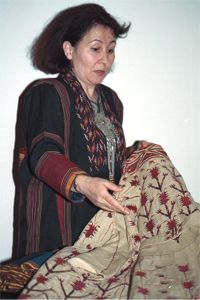Posted by Steve Price on 09-24-2002 10:48 AM:
The importance of procreation
Hi Fred,
First, add my compliments to John Howe's. Your bands are
a treat, and reproduction in the arts of western and central Asia are too
rarely discussed.
One point I'd raise is the importance of procreation.
In your essay, you mention the responsibility to the community that a couple
has - to provide the next generation of members. John takes a similar tack in
his opening post.
I think there's another important element that we
tend to forget because it isn't very significant in modern western society. It
is that having children is the couple's route to not being destitute when they
get old. In most societies, including our own until fairly recently, the
children had the responsibility of caring for their elderly parents. Not having
children, therefore, had serious consequences to the couple, not just to the
community. And, of course, procreation of the livestock is central to the
economy in pastoral societies.
The genitalia and the navel are extremely
prominent features of African tribal sculpture, and images similar to those the
Persian bands are also widely used in southeast Asian tribal arts. In fact,
sexual and reproductive imagery is important in the arts of virtually all
cultures, partly for the reason I just outlined and partly because of the
connection it implies between the individual, ancestors and future descendents.
That is, it is a reminder of the familial bond and all that it
implies.
Regards,
Steve Price
Posted by R. John Howe
on 09-24-2002 04:25 PM:
Seems Also Reflected in "Award" of White Chyrpys
Steve et al -
A few years ago, Adjap Bairieva, a Turkmen lady and
textile expert, came to some of the rugs clubs and talked, among other things,
about the various colored chyrpys that western Turkmen women wore (and
sometimes apparently still wear on occasion).

I asked her explicitly whether the colors had
significances that we heard about informally. She was quick to say that they
did.
Here is my remembrance of them:
Black ground - unmarried
girls
Yellow ground - married women
Green ground - (this one I'm not sure
of) perhaps, a widow
White ground - "Awarded to some women" 60 years or
older.
I pressed her about the criteria that would be used to justify
the award of a white chyrpy. She said that the person would have to be
recognized generally in the community to have been a "good woman," and that a
definite part of this is that she must have been a "mother."
Now this
seems blatantly unfair from our now "more enlightened" perspective, but you can
see that it is a continuing reflection of this same value.
I was not
able to get clear about the process through with a chyrpy is awarded. But the
"award" characterization indicates that it was/is honorific and that not every
woman who reached 60 could don one.
Regards,
R. John Howe
Posted by Steve Price on 09-24-2002 05:14 PM:
Hi John,
Some of the wives of European royalty were killed if
they didn't bear sons. Compared to this part of the our western tradition, not
being allowed to wear a white chyrpy seems pretty
enlightened.
Regards,
Steve Price
Posted by R. John
Howe on 09-24-2002 06:43 PM:
Steve -
I mentioned the "unfairness" only to defuse that
potential issue and to permit folk to focus instead on the fact that the
possible award of a white chyrpy, toward the end of a Turkmen woman's life, is
in part driven by the same concerns that are also reflected in the signals
given by the community to a couple as they marry.
There is a
consistency here that suggests something about its importance in traditional
societies.
Regards,
R. John Howe
Posted by
Fred_Mushkat on 09-25-2002 04:02 AM:
Hi Steve,
You have made a good point about the importance of
taking care of the elderly. This practice exists in the weaving areas under
discussion; a good reference of this can be found in Lois Beck's text 'Nomad',
which many Turkotek followers know to be an excellent source of information
about daily life among the Qashqa'i. I don't recall ever seeing an image in
tribal weavings specifically representing an elderly individual, but it is
likely that many of the master weavers came from this age group.
The
representation of sexual themes appears in many cultures, and the African
examples are a well known type. Many ancient artifacts show birthing and other
reproductive events; the Central and South American weavings, sculptures, and
pottery come to mind. Although I am not an expert on Islam, I suspect that the
relative rarity of these images in Iranian weavings of any type is no doubt
influenced in part by the religion of the peoples in all substrates of society.
It is my position that the nomads of Iran were the least restrained by the
societal pressures which make these images so uncommon on any but tribal
textiles.
Regards,
Fred Mushkat
